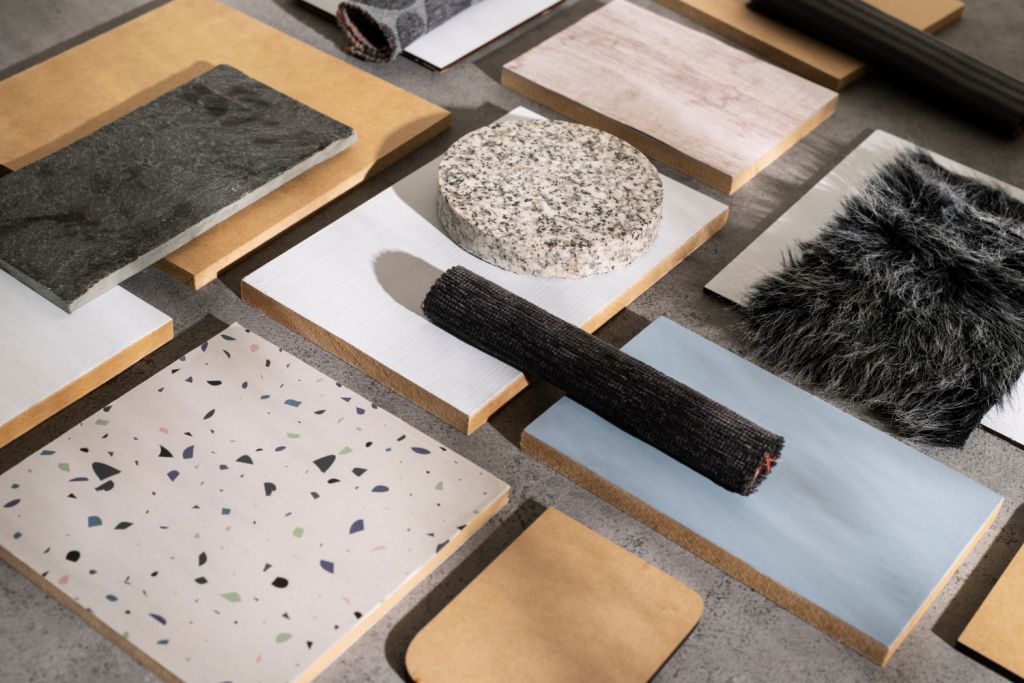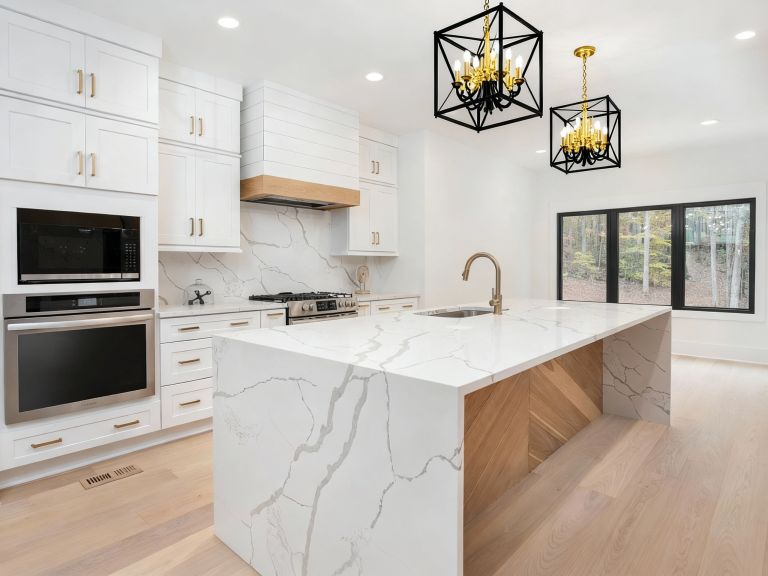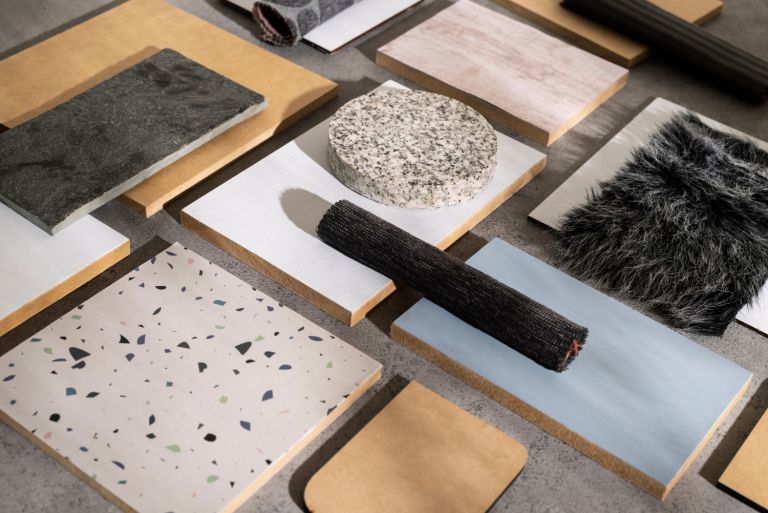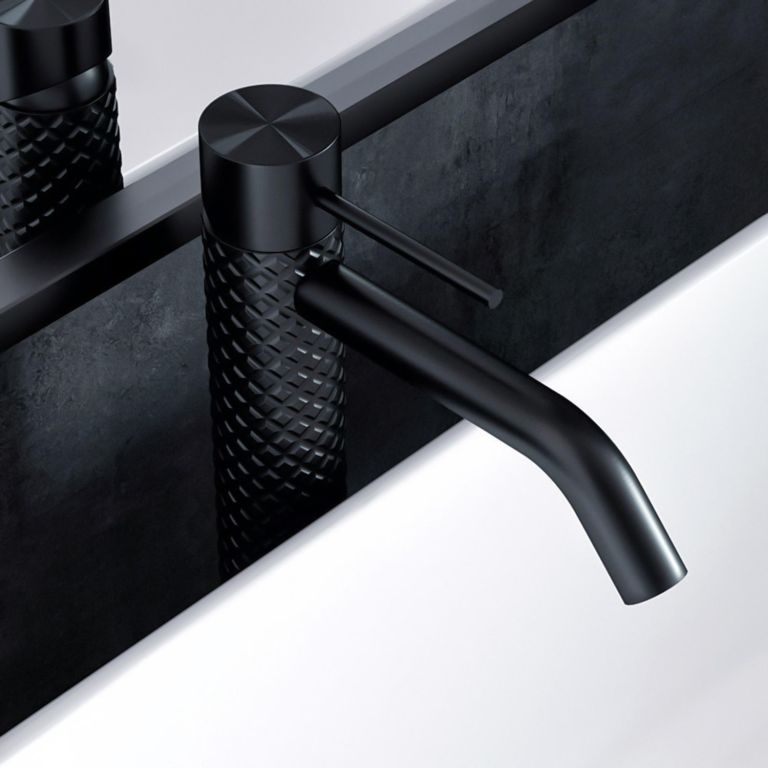The Tile Decision That Defines Your Space
Tile selection ranks among the most impactful design decisions in kitchen and bathroom renovations. The material you choose affects aesthetics, maintenance requirements, durability, and long-term satisfaction. For Bay Area homeowners, the choice often comes down to porcelain or natural stone.
At Greenberg Design Gallery, we guide clients through this decision daily. Both materials offer distinct advantages, and the right choice depends on your priorities, budget, and lifestyle. This comprehensive comparison provides the information you need to choose confidently.
Understanding the Materials
Porcelain Tile
Porcelain is manufactured from refined clay fired at extremely high temperatures (2,200-2,500°F). This process creates a dense, nearly impervious material with consistent properties throughout each tile.
Natural Stone Tile
Natural stone includes marble, granite, travertine, limestone, and slate. Each piece is quarried from the earth, cut to size, and finished for installation. No two tiles are identical.
Durability and Performance
Porcelain Strengths
- Extremely hard and dense (PEI rating 4-5)
- Highly scratch resistant
- Water absorption under 0.5 percent
- Stain resistant when properly sealed
- Chip resistant
- Unaffected by temperature fluctuations
- Lifespan: 50+ years with minimal wear
Natural Stone Performance
- Hardness varies by stone type (marble softer, granite harder)
- More porous than porcelain (varies by stone)
- Can scratch, stain, or etch depending on type
- Requires periodic sealing
- Some stones crack with temperature changes
- Lifespan: 25-75+ years depending on stone and care
For high-traffic kitchens and busy bathrooms, porcelain delivers superior durability. Natural stone requires more care but offers unmatched natural beauty.
Water Resistance and Moisture Performance
Porcelain
- Nearly waterproof (less than 0.5 percent water absorption)
- Ideal for wet areas (shower floors, tub surrounds)
- No sealing required
- Grout is only concern for moisture penetration
- Mold and mildew resistant
Natural Stone
- Porosity varies dramatically by type:
- Granite: Low porosity (good for wet areas)
- Marble: Medium porosity (needs sealing)
- Travertine/Limestone: High porosity (challenging in wet areas)
- Requires quality sealers reapplied every 1-3 years
- Can develop water stains without proper sealing
- Some stones unsuitable for shower floors
For Bay Area bathrooms and kitchen backsplashes near sinks, porcelain provides worry-free moisture resistance. Natural stone works beautifully in drier applications or when homeowners commit to proper maintenance.
Maintenance Requirements
Porcelain Maintenance
- Daily: Sweep or vacuum
- Weekly: Damp mop with mild cleaner
- Periodic: Clean grout lines
- No sealing required
- Resists most household chemicals
- Very low maintenance commitment
Natural Stone Maintenance
- Daily: Sweep or vacuum
- Weekly: Damp mop with pH-neutral stone cleaner
- Annually: Reseal (frequency depends on stone type)
- Immediate cleanup of acidic spills (wine, citrus, vinegar)
- Avoid harsh chemicals
- Polish some stones periodically
- Higher maintenance commitment
Time investment: Porcelain requires 80 percent less maintenance than natural stone over its lifetime.
Aesthetic Differences
Porcelain Capabilities
Modern manufacturing creates porcelain that mimics natural materials remarkably well:
- Realistic stone looks (marble, travertine, slate)
- Wood-look planks indistinguishable from hardwood
- Concrete and industrial aesthetics
- Unlimited colors and patterns
- Consistent appearance across tiles
- Large format options (48″ x 120″)
- Rectified edges for tight grout lines
Natural Stone Beauty
Natural stone offers authenticity no manufactured product can match:
- Unique veining and color variation
- Depth and character
- Natural texture
- Organic patterns
- Prestige and luxury associations
- Patina that develops over time
- Connection to nature
For clients valuing authenticity and natural materials, stone wins aesthetically despite advances in porcelain technology. For those prioritizing consistency and specific looks, porcelain offers more control.
Cost Comparison
Porcelain Tile Pricing (2025 Bay Area)
- Standard porcelain: 3−3−8 per square foot
- Premium porcelain (stone look): 8−8−18 per square foot
- Designer collections: 15−15−35 per square foot
- Large format tiles: Add 20-30 percent
- Installation: 8−8−15 per square foot
- Total installed: 11−11−50 per square foot
Natural Stone Pricing (2025 Bay Area)
- Travertine: 8−8−15 per square foot
- Limestone: 10−10−20 per square foot
- Slate: 12−12−25 per square foot
- Marble: 15−15−45 per square foot
- Granite: 20−20−50 per square foot
- Exotic stones: 40−40−150+ per square foot
- Installation: 12−12−25 per square foot (more complex)
- Total installed: 20−20−175 per square foot
Natural stone generally costs 40-80 percent more than comparable porcelain. Installation costs run higher due to stone’s weight, fragility, and cutting difficulty.
Installation Considerations
Porcelain Installation
- Standard tile installation techniques
- Cuts cleanly with wet saw
- Lighter weight (easier handling)
- Rectified edges allow minimal grout lines (1/16″)
- Large formats require skilled installers
- Setting time: Standard
Natural Stone Installation
- Requires experienced stone installers
- Cuts slowly, requires diamond blades
- Heavier (structural considerations for large areas)
- Natural edges require wider grout lines (1/8″-1/4″)
- Sealing before and after grouting recommended
- Extended curing time before sealing
Installation timeline: Natural stone takes 20-30 percent longer than porcelain for comparable areas.
Environmental Considerations
Porcelain Environmental Impact
- Manufacturing energy-intensive
- Recycled content available in some products
- Extremely long lifespan reduces replacement
- No ongoing chemical maintenance needed
- Local manufacturing reduces transportation impact
Natural Stone Environmental Impact
- Quarrying creates environmental disturbance
- Heavy material increases transportation emissions
- No manufacturing energy required (beyond cutting/finishing)
- Completely natural material
- Requires chemical sealers periodically
- Biodegradable end-of-life
Both materials have environmental trade-offs. Natural stone is renewable but heavy. Porcelain requires manufacturing energy but lasts indefinitely.
Application-Specific Recommendations
Kitchen Floors
- Best Choice: Porcelain
- Why: High traffic, spill exposure, durability needs
- Alternative: Granite or slate for lower-traffic kitchens
Kitchen Backsplashes
- Best Choice: Either works well
- Porcelain: Easy maintenance near cooking areas
- Natural Stone: Marble, travertine create luxury aesthetic
- Consider: Honed marble beautiful but requires maintenance commitment
Bathroom Floors
- Best Choice: Porcelain
- Why: Water resistance, slip resistance options, durability
- Alternative: Granite or slate work well with proper sealing
Shower Walls
- Best Choice: Porcelain
- Why: Waterproof, no sealing, consistent appearance
- Alternative: Marble creates classic luxury look (requires maintenance)
Powder Room Walls
- Best Choice: Natural stone (luxury impact)
- Why: Low moisture exposure, high visual impact
- Alternative: Premium porcelain for budget savings
Fireplace Surrounds
- Best Choice: Natural stone (heat-resistant)
- Why: Authentic material, heat tolerance, design impact
- Alternative: Porcelain rated for heat exposure
Popular Stone Types Compared
Marble
- Appearance: Classic elegance, beautiful veining
- Durability: Softer, scratches and etches easily
- Maintenance: High (frequent sealing, immediate spill cleanup)
- Cost: 15−15−45 per sf
- Best for: Low-traffic areas, powder rooms, walls
Granite
- Appearance: Varied patterns, speckled or veined
- Durability: Very hard, scratch resistant
- Maintenance: Moderate (annual sealing)
- Cost: 20−20−50 per sf
- Best for: Kitchen floors, high-traffic areas
Travertine
- Appearance: Warm tones, natural pitting
- Durability: Moderate, porous
- Maintenance: High (regular sealing, careful cleaning)
- Cost: 8−8−15 per sf
- Best for: Backsplashes, accent walls (not wet areas)
Slate
- Appearance: Rustic, layered texture
- Durability: Hard but can flake
- Maintenance: Moderate (annual sealing)
- Cost: 12−12−25 per sf
- Best for: Floors, rustic/modern aesthetics
Limestone
- Appearance: Soft, elegant, subtle variation
- Durability: Soft, scratches easily
- Maintenance: High (frequent sealing, careful use)
- Cost: 10−10−20 per sf
- Best for: Low-traffic areas, design statement
Case Study: Palo Alto Kitchen Renovation
A client at Greenberg Design Gallery recently renovated their kitchen and faced the porcelain vs. stone decision.
Project Details
- Kitchen size: 250 square feet floor area
- Backsplash: 60 square feet
- Budget: Moderate to high
- Lifestyle: Busy family with young children
- Priorities: Durability and easy maintenance
Decision Process
Initial Preference: Carrara marble floor and backsplash for classic elegance
Reality Check:
- Three children under 10 years old
- Frequent cooking and entertaining
- Limited time for maintenance
- Marble’s susceptibility to etching from acidic spills
Final Selection
Floor: Premium porcelain in marble-look finish
- Product: 24″ x 48″ rectified porcelain
- Appearance: Convincing Carrara marble simulation
- Cost: 12persf(12persf(3,000 materials)
- Installation: 10persf(10persf(2,500)
- Total: $5,500
Backsplash: Genuine Carrara marble
- Product: 3″ x 6″ honed marble subway tile
- Appearance: Authentic marble beauty
- Cost: 18persf(18persf(1,080 materials)
- Installation: 18persf(18persf(1,080)
- Sealing: $200
- Total: $2,360
Results
- Floor performs flawlessly with zero maintenance
- Backsplash provides authentic marble beauty
- Lower moisture exposure allows sustainable maintenance
- Total savings vs. all-marble: $4,500
- Family satisfied 18 months later: “Best decision we made”
This hybrid approach balanced beauty, practicality, and budget effectively.
Long-Term Value Considerations
Porcelain Lifecycle Costs
- Initial cost: Moderate
- Maintenance: Minimal (grout cleaning only)
- Repair: Individual tiles replaceable
- 20-year cost: Initial investment only
Natural Stone Lifecycle Costs
- Initial cost: High
- Maintenance: Ongoing sealing (200−200−500 every 1-3 years)
- Repair: More complex, matching challenging
- Potential refinishing: 5−5−10 per sf every 10-15 years
- 20-year cost: Initial + 2,000−2,000−8,000 maintenance
For a 300 sf installation:
- Porcelain 20-year total: 6,000−6,000−15,000
- Natural stone 20-year total: 9,000−9,000−25,000+
Design Versatility
Porcelain Advantages
- Consistent color and pattern matching
- Large format options reduce grout lines
- Unlimited design possibilities
- Can match any aesthetic (traditional, modern, rustic)
- Easy to find additional tiles for future needs
Natural Stone Advantages
- Each installation unique
- Organic patterns and variation
- Depth that manufactured products cannot fully replicate
- Prestige and luxury perception
- Aging gracefully with patina development
For clients seeking predictable, controlled designs, porcelain excels. For those embracing natural variation and organic beauty, stone delivers authenticity.
Common Misconceptions
“Porcelain looks fake”
Modern porcelain technology creates remarkably realistic stone looks. High-quality porcelain challenges even design professionals to distinguish from natural stone in photos.
“Natural stone is always better quality”
Stone is natural, not necessarily superior. Porcelain often outperforms stone in durability, water resistance, and consistency.
“Porcelain is cheap”
Premium porcelain costs nearly as much as mid-range natural stone. Quality relates to manufacturing technology, not material inherent value.
“Stone always adds more value”
Home value comes from overall design quality, not just material authenticity. Beautifully designed spaces with quality porcelain often appraise higher than poorly designed spaces with natural stone.
Making Your Decision
Choose Porcelain If You:
- Prioritize durability and low maintenance
- Have active household (kids, pets)
- Want consistent, predictable appearance
- Need maximum water resistance
- Have moderate budget
- Prefer modern, clean aesthetics
- Value long-term cost savings
Choose Natural Stone If You:
- Love authentic natural materials
- Accept ongoing maintenance commitment
- Have budget for premium materials
- Value organic variation and uniqueness
- Prefer traditional or luxury aesthetics
- Understand material characteristics and limitations
- Want prestige materials
Greenberg Design Gallery’s Recommendations
Kitchen Floors: Porcelain
Superior durability and maintenance make porcelain ideal for kitchen traffic and spills.
Kitchen Backsplashes: Personal preference
Both work well. Natural stone adds luxury; porcelain offers easier maintenance.
Bathroom Floors: Porcelain
Water resistance and slip-resistance options make porcelain safer and more durable.
Shower Walls: Porcelain
Constant water exposure favors porcelain’s waterproof properties.
Powder Rooms: Natural stone
Low moisture, low traffic allows stone’s beauty to shine without maintenance burden.
Fireplace Surrounds: Natural stone
Heat resistance and dramatic visual impact make stone ideal.
Visit Greenberg Design Gallery in Palo Alto to see both materials in person. Our showroom displays help you understand the real-world appearance, texture, and differences between porcelain and natural stone options.
Installation and Labor
Porcelain Installation
- Standard tile installation methods
- Most contractors comfortable with material
- Lighter weight simplifies handling
- Clean cuts with standard tools
- Labor: 8−8−15 per square foot Bay Area
Natural Stone Installation
- Requires experienced stone installers
- Heavier material demands careful handling
- Stone-specific cutting tools required
- Must account for variation during layout
- Often requires back-buttering for full adhesion
- Labor: 12−12−25 per square foot Bay Area
Labor cost differences add up. For 200 square foot installation:
- Porcelain labor: 1,600−1,600−3,000
- Natural stone labor: 2,400−2,400−5,000
- Difference: 800−800−2,000
Slip Resistance for Safety
Porcelain Options
- Textured surfaces available in any finish level
- Standardized slip-resistance ratings (COF)
- Consistent performance across production
- Options range from highly polished to heavily textured
Natural Stone Options
- Natural cleft finishes provide good slip resistance
- Honed finishes moderate slip resistance
- Polished finishes slippery when wet
- Variation between individual tiles affects performance
For shower floors and wet areas, specify slip-resistant finishes regardless of material. Porcelain offers more consistent slip-resistance options.
Color and Finish Options
Porcelain Variety
- Unlimited colors through pigmentation
- Finish options: Polished, matte, textured, embossed
- Consistent color throughout production run
- Easy to reorder matching tiles
- New designs released continuously
Natural Stone Variety
- Color determined by mineral composition
- Finish options: Polished, honed, brushed, tumbled, cleft
- Significant variation between quarry runs
- Matching future orders challenging
- Limited to naturally occurring colors and patterns
Color consistency matters more in some applications. Continuous spaces benefit from porcelain’s uniformity. Accent areas can embrace stone’s variation.
Real-World Performance in Bay Area Homes
Climate Factors
Bay Area’s mild Mediterranean climate treats both materials well:
- Minimal freeze-thaw concerns
- Moderate humidity levels
- No extreme temperature swings
However, earthquake considerations matter:
- Porcelain’s flexibility handles movement better
- Natural stone (especially marble) can crack during seismic events
- Proper installation techniques critical for both
Lifestyle Factors
Bay Area lifestyles often include:
- Frequent entertaining (spills and traffic)
- Wine consumption (acidic threat to marble and limestone)
- Active families with children and pets
- Indoor-outdoor living (tracking dirt)
- Environmental consciousness
These factors generally favor porcelain’s durability and low maintenance, though environmentally conscious clients may prefer natural stone’s sustainable origin.
Resale Value Impact
Buyer Perceptions
Both materials appeal to buyers when well-executed:
- Natural stone signals luxury and prestige
- Quality porcelain demonstrates smart, durable design choices
- Poor installation hurts value regardless of material
- Overall design quality matters more than material choice alone
ROI Considerations
- Premium porcelain: 60-70 percent material cost recovery
- Natural stone: 50-60 percent material cost recovery
- Neither guarantees dollar-for-dollar value increase
- Both support overall home value when part of quality renovation
Hybrid Approaches
Many Greenberg Design Gallery clients use both materials strategically:
Common Combinations
- Porcelain floors + natural stone backsplash
- Porcelain shower + stone accent wall
- Porcelain field tiles + stone border
- Different materials for different rooms
This approach captures benefits of both: porcelain durability where needed, natural stone beauty for impact.
Grout Considerations
Grout affects appearance and maintenance regardless of tile material.
Grout Width
- Porcelain rectified: 1/16″ grout lines possible
- Natural stone: 1/8″-1/4″ lines typical (accounts for variation)
Tighter grout lines create sleeker, more contemporary looks. Natural stone’s variation requires wider lines.
Grout Color
- Matching grout minimizes tile visibility (subtle)
- Contrasting grout emphasizes tile pattern (bold)
- Epoxy grout resists staining better than cement grout
- Light grout with dark tile shows dirt quickly
Popular Porcelain Collections at Greenberg Design Gallery
Marble-Look Porcelain
- Italian manufacturers excel at marble simulation
- Calacatta and Carrara patterns most popular
- Realistic veining at fraction of marble cost
- Large format slabs available (matching bookmatch patterns)
Wood-Look Porcelain Planks
- Indistinguishable from hardwood in most applications
- Ideal for kitchens and bathrooms where wood impractical
- No expansion/contraction concerns
- Waterproof unlike real wood
Concrete and Industrial Looks
- Modern aesthetic without concrete’s maintenance issues
- Uniform color without concrete’s inherent variation
- Warmer underfoot than actual concrete
Natural Stone Selection at Greenberg Design Gallery
Our Palo Alto showroom features:
Marble Selection
- Carrara, Calacatta, Statuario
- International and domestic sources
- Slabs and tile available
- Honed and polished finishes
Granite Options
- Speckled and veined patterns
- Durable and practical
- Wide color range
- Suitable for heavy use
Travertine and Limestone
- Warm, Mediterranean aesthetics
- Filled and unfilled options
- Various finishes available
Specialty Stones
- Soapstone for authentic farmhouse looks
- Quartzite for durability with marble aesthetics
- Onyx for dramatic backlit applications
Visit our showroom to see full slabs, understand variation, and make informed selections.
Final Thoughts
The porcelain vs. natural stone decision hinges on your priorities. Porcelain delivers superior durability, easier maintenance, and excellent value. Natural stone provides authentic beauty, prestige, and connection to natural materials.
Neither choice is wrong. Both create beautiful, lasting installations when selected appropriately and installed properly. Success comes from understanding each material’s characteristics and matching them to your application, lifestyle, and maintenance willingness.
At Greenberg Design Gallery, we help Bay Area homeowners navigate this decision with access to premium porcelain and natural stone options, expert guidance, and installation coordination. Our Palo Alto showroom allows you to see, touch, and compare materials before committing.
Whether you choose porcelain’s practicality or stone’s authenticity, we ensure your tile selection perfectly suits your design vision and daily life.
Visit Greenberg Design Gallery to explore our complete tile and stone collection, discuss your project with our design team, and discover the perfect material for your kitchen or bathroom renovation.






